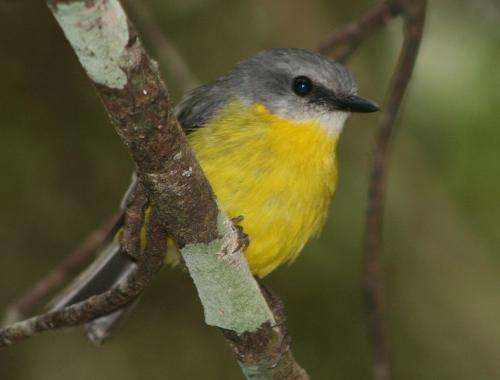March 12, 2013 report
Study shows urban noise leads to less songbird diversity

(Phys.org) —A team of Canadian researchers has found that anthropogenic noise (noise created by people that impacts other species) in urban areas leads to less songbird diversity. In their paper published in the journal Global Change Biology, the researchers describe how in studying songbird diversity in and around the city of Edmonton, they noted that songbirds that sang in low frequencies tended to have difficulty in communicating when having to compete with urban noise, leading to less mating and offspring production.
Many cities around the world have begun to implement plans to host songbirds—they are seen as an attractive feature in parks and other semi-natural settings. Unfortunately, such efforts have not lived up to expectations in many areas as diversity has been much lower than anticipated. Seeking to discover why, this new research effort focused on the idea that many songbirds may have trouble competing with urban noise, and as a result, fail to thrive.
The researchers surveyed 113 natural sites in and around the city of Edmonton Canada, noting the richness of songbird diversity, as well as elements commonly associated with their habitat, such as vegetation, food source etc. In analyzing their data, the team found a correlation between high urban noise level and songbird diversity—the more noise, the fewer the number of species. More specifically, they found that those songbirds that sang in low frequencies were more adversely impacted by urban noise, which they note generally comes from traffic, which also creates a lot of low frequency noise.
The researchers suggest that interference from low frequency traffic noise could cause interruptions in mating songs in addition to general communication problems between the birds, leading to less mating, and fewer offspring. The result is urban environments that favor songbirds that sing in high frequencies, at the expense of those that are more heavily impacted by noise in their environment, i.e. less diversity.
The team also studied seven particular species of songbirds to see if their numbers decreased as the level of noise around them increased, and found that the three species that sang in low frequencies did indeed show smaller and smaller population levels as the level of urban noise in the area increased.
More information: Anthropogenic noise decreases urban songbird diversity and may contribute to homogenization, Global Change Biology, Volume 19, Issue 4, pages 1075–1084, April 2013. DOI: 10.1111/gcb.12098
Abstract
More humans reside in urban areas than at any other time in history. Protected urban green spaces and transportation greenbelts support many species, but diversity in these areas is generally lower than in undeveloped landscapes. Habitat degradation and fragmentation contribute to lowered diversity and urban homogenization, but less is known about the role of anthropogenic noise. Songbirds are especially vulnerable to anthropogenic noise because they rely on acoustic signals for communication. Recent studies suggest that anthropogenic noise reduces the density and reproductive success of some bird species, but that species which vocalize at frequencies above those of anthropogenic noise are more likely to inhabit noisy areas. We hypothesize that anthropogenic noise is contributing to declines in urban diversity by reducing the abundance of select species in noisy areas, and that species with low-frequency songs are those most likely to be affected. To examine this relationship, we calculated the noise-associated change in overall species richness and in abundance for seven common songbird species. After accounting for variance due to vegetative differences, species richness and the abundance of three of seven species were reduced in noisier locations. Acoustic analysis revealed that minimum song frequency was highly predictive of a species' response to noise, with lower minimum song frequencies incurring greater noise-associated reduction in abundance. These results suggest that anthropogenic noise affects some species independently of vegetative conditions, exacerbating the exclusion of some songbird species in otherwise suitable habitat. Minimum song frequency may provide a useful metric to predict how particular species will be affected by noise. In sum, mitigation of noise may enhance habitat suitability for many songbird species, especially for species with songs that include low-frequency elements.
Journal information: Global Change Biology
© 2013 Phys.org

















